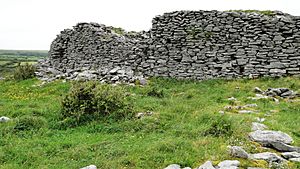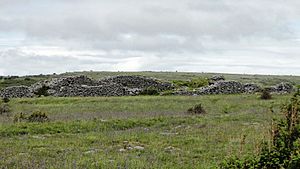Cahercommaun facts for kids
|
Cathair Chomáin
|
|

Detail of part of the inner wall
|
|
| Location | Parish of Kilnaboy, the Burren |
|---|---|
| Region | Ireland |
| Coordinates | 53°00′53″N 9°04′14″W / 53.014722°N 9.070556°W |
| Type | Ringfort |
| History | |
| Material | limestone |
| Periods | early Medieval |
| Site notes | |
| Excavation dates | 1934 (Harvard Archaeological Expedition) 2003 |
| Archaeologists | Hugh O’Neill Hencken |
| Ownership | Public |
| Public access | Yes |
| Reference no. | 270 |
Cahercommaun (Irish: Cathair Chomáin) is an amazing ancient stone fort in Ireland. It is sometimes called Cahercommane. You can find it on the edge of the Burren area in County Clare. This special fort was built a long time ago, in the 800s. It is known as a ringfort because of its circular shape.
What is Cahercommaun?
Cahercommaun sits right on the edge of a tall cliff. It looks out over a beautiful wooded valley. The fort has three huge circular walls. These walls stretch all the way to the cliff edge.
The innermost wall is the strongest and thickest. It forms almost a full circle. The two outer walls are shaped more like a semicircle. They are connected to each other, like a fan. Building just the inner wall needed about 16,500 tons of stone!
The outer wall is about 350 feet wide from east to west. It is about 245 feet long from north to south. The inner wall is about 5 feet thick. It stands 4 feet high and rises 12 to 14 feet above the cliff. Inside the innermost wall, there are three hidden rooms.
Digging Up the Past
Archaeologists are like history detectives. They dig up old sites to learn about the past. In 1934, a team from Harvard University explored Cahercommaun. This team was led by a man named Hugh O’Neill Hencken. They spent six weeks digging at the site.
They found that the circular fort once had at least twelve stone buildings. Some of these buildings even had secret underground passages called souterrains. The archaeologists believed that about 40 people lived at Cahercommaun.
Amazing Discoveries
The team found many interesting objects during their dig. They found wooden spindles, which were used for weaving cloth. One very special find was a silver brooch. It was found in one of the souterrains. This brooch looks a lot like the famous Tara Brooch. It showed that the fort was already there in the 800s. Today, you can see this brooch at the National Museum of Ireland in Dublin. They also found an old padlock.
The discoveries at Cahercommaun are very important. They are some of the best Iron Age items found in Ireland. For example, a set of sheep shears and a saddle quern were found. A quern is a special stone used for grinding grain. These items are now on loan to the Clare Museum.
Archaeologists found signs that people lived here even earlier. They found evidence of settlement from the 400s and 500s. Even though the fort itself was built in the 800s. The saddle quern is even older. It dates back to the Late Neolithic (New Stone Age) or Early Bronze Age.
The work done in 1934 was a great start. It helped experts learn a lot about Cahercommaun. Newer information has helped update some of the first ideas. But the 1934 dig gave us a strong base for understanding this ancient place.



